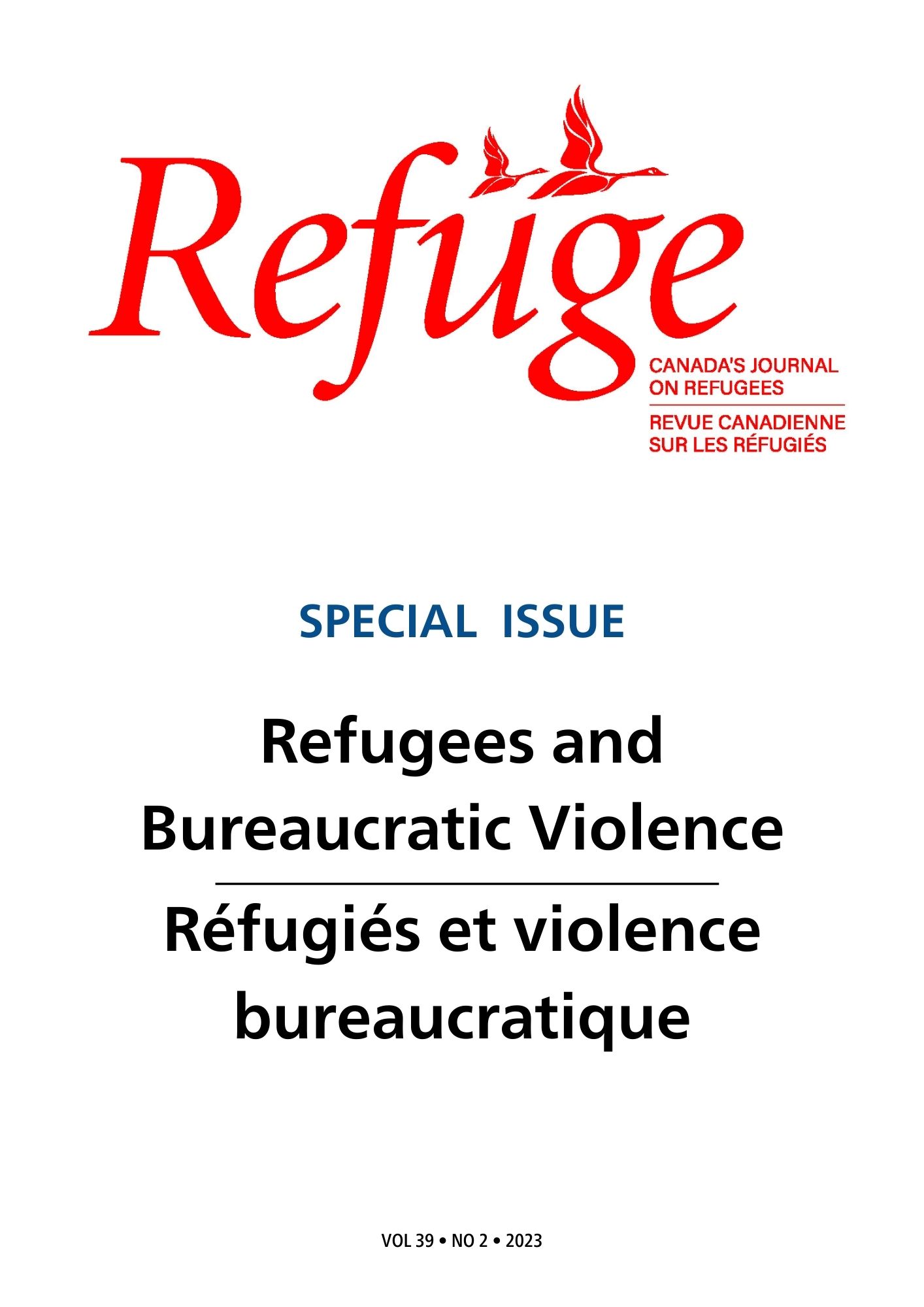Sisters-in-Waiting: A Case Study of Displaced Syrian Women Fostering New Senses and Memories of Home in Lebanon
DOI:
https://doi.org/10.25071/1920-7336.41087Keywords:
protracted displacement, agency-in-waiting, multi-sensorial, homemaking, female friendship, Syrian womenAbstract
Building on variously located Syrian women’s accounts of their day-to-day lives in Lebanon, this article illuminates meaning-making processes in protracted displacement, defined by the UNHCR (2004, p. 1) as a “long-lasting and intractable state of limbo.” We draw on the metaphor of a “constellation of homes” (Brun & Fábos, 2015) to explore various homemaking practices and the interconnected temporal and multi-sensorial dimensions thereof. In so doing, we counter narratives of displaced women as a homogenous collective and problematic assumptions of stasis and passivity associated with protracted displacement. Particular attention is paid to women’s narratives regarding “purposeful work” and, crucially, female friendship, which we argue can be understood as additional nodes in the constellation of homes. We argue that further and different forms of research are required to do justice to the multi-sensorial dimensions of homemaking and the novel concept of “sisters-in-waiting” in the lives of women in protracted displacement.
Metrics
References
Abu-Lughod, L. (1991). Writing against culture. In R. G. Fox (Ed.), Recapturing anthropology: Working in the present (pp. 137–162). School of American Research Press.
Ahmed, S. (1999). Home and away. Narratives of migration and estrangement, International Journal of Cultural Studies, 2(3), 329–347. https://doi.org/10.1177/136787799900200303
Ayoub, M. (2017). Gender, social class and exile: The case of Syrian women in Cairo. In J. Freeman, Z. Kivilcim, & N. Ö. Baklacoglu (Eds.), A gendered approach to the Syrian refugee crisis (pp. 77–104). Routledge. https://doi.org/10.4324/9781315529653-6
Bardelli, N. (2022). A hierarchy of refugees: Fixing vulnerability among refugees from Mali in Burkina Faso. Public Anthropologist, 4(2), 135–159. https://doi.org/10.1163/25891715-bja10038
Blunt, A., & Dowling, R. (2022). Home (2nd ed.). Routledge. https://doi.org/10.4324/9780429327360
Boccagni, P., & Hondagneu-Sotelo, P. (2023). Integration and the struggle to turn space into “our” place: Homemaking as a way beyond the stalemate of assimilationism vs transnationalism. International Migration, 61, 154–167. https://doi.org/10.1111/imig.12846
Brah, A., & Clini, C. (2017). Open space: Contemporary feminist discourses and practices within and across boundaries: An interview with Avtar Brah. Feminist Review, 117(1), 163–170. https://doi.org/10.1057/s41305-017-0079-2
Bremmer, M., Hermans, C., & Lamers, V. (2021). The charmed dyad: Multimodal music lessons for pupils with severe or multiple disabilities. Research Studies in Music Education, 43(2), 259–272. https://doi.org/10.1177/1321103X20974802
Brun, C. (2015). Active waiting and changing hopes: Toward a time perspective on protracted displacement. Social Analysis, 59(1), 19–37. https://doi.org/10.3167/sa.2015.590102
Brun, C., & Fábos, A. (2015). Making homes In limbo? A conceptual framework. Refuge: Canada’s Journal on Refugees, 31(1), 5–17. https://doi.org/10.25071/1920-7336.40138
Čapo, J. (2015). “Durable solutions,” transnationalism, and homemaking among Croatian and Bosnian former refugees. Refuge: Canada’s Journal on Refugees, 31(1), 19–30. https://doi.org/10.25071/1920-7336.40139
Dijstelbloem, H. (2023, June 28). Moving the immovable. Climate migration and the multiple tensions between mobility and immobility [Keynote lecture]. STS Italia Conference 2023, University of Bologna, Bologna, Italy.
Dudley, S. (2011). Feeling at home: Producing and consuming things In Karenni refugee camps on the Thai–Burma border. Population, Space And Place, 17(6), 742–755. https://doi.org/10.1002/psp.639
Ebaugh, H. R., & Curry, M. (2000). Fictive kin as social capital in new immigrant communities. Sociological Perspectives, 43(2), 189–209. https://doi.org/10.2307/1389793
Etzold, B., & Fechter, A.-M. (2022). Unsettling protracted displacement: connectivity and mobility beyond “limbo.” Journal of Ethnic and Migration Studies, 48(18), 4295–4312. https://doi.org/10.1080/1369183X.2022.2090153
Fábos, A. (2015). Microbuses and mobile homemaking in exile: Sudanese visiting strategies in Cairo. Refuge: Canada’s Journal on Refugees, 31(1), 55–66. https://doi.org/10.25071/1920-7336.40149
Fawaz, M., Gharbieh, A., Harb, M., & Salamé, D. (Eds.). (2018, September). Refugees as city-makers. Issam Fares Institute for Public Policy and International Affairs, American University of Beirut. https://www.aub.edu.lb/ifi/Documents/publications/research_reports/2018-2019/20180910_refugees_as_city_makers.pdf
Grawert, E., & Mielke, K. (2018). Coping with protracted displacement: How Afghans secure their livelihood in Afghanistan, Iran and Pakistan [Working paper]. Bonn International Center for Conversion (BICC). https://nbn-resolving.org/urn:nbn:de:0168-ssoar-61301-9
Hart, J., Paszkiewicz, N., & Albadra, D. (2018). Shelter as home? Syrian homemaking in Jordanian refugee camps. Human Organization, 77(4), 371–380. https://doi.org/10.17730/0018-7259.77.4.371
Howes, D. (2019). Multisensory anthropology. Annual Review of Anthropology, 48(1), 17–28. https://doi.org/10.1146/annurev-anthro-102218-011324
Hyndman, J., & Giles, W. (2011) Waiting for what? The feminization of asylum in protracted situations. Gender, Place and Culture: A Journal of Feminist Geography, 18(3), 361–337. https://doi.org/10.1080/0966369X.2011.566347
Lindqvist, M. (2011). The flower girl: A case study in sense memory. In J. Creet & A. Kitzmann (Eds.), Memory and migration (pp. 183–193). University of Toronto Press. https://www.jstor.org/stable/10.3138/j.ctt2ttzkd.14
Loescher, G., & Milner, J. (2008). Understanding the problem of protracted refugee situations. In G. Loescher, J. Milner, E. Newman, & G. Troeller (Eds.), Protracted refugee situations: Political, human rights and security implications (pp. 20–42). United Nations University Press. https://archive.unu.edu/unupress/sample-chapters/protracted_refugee_situation_web.pdf
Lokot, M. (2020). “Blood doesn’t become water”? Syrian social relations during displacement. Journal of Refugee Studies, 33(3), 555–576. https://doi.org/10.1093/jrs/fey059
Massey, D. (1994). Space, place and gender. Polity Press
Massey, D. (2004). Geographies of responsibility. Geografiska Annaler. Series B, Human Geography, 86(1), 5–18. https://doi.org/10.1111/j.0435-3684.2004.00150.x
Meijering, L., & Bailey, A. (2023). Homemaking and cohousing by postcolonial migrants in later life. In P. Boccagni (Ed.), Handbook on home and migration (pp. 426–437). Edward Elgar Publishing. https://doi.org/10.4337/9781800882775.00047
Mendola, D., & Pera, A. (2021). Vulnerability of refugees: Some reflections on definitions and measurement practices. International Migration, 60(5), 108–121. https://doi.org/10.1111/imig.12942
Miedema, E. (2016). “Let’s move, let’s not remain stagnant”: Nationalism, masculinism, and school-based education in Mozambique. In Z. Millei & R. Imre (Eds.), Childhood and nation: Interdisciplinary engagements (pp.183–206). Palgrave MacMillan. https://doi.org/10.1057/9781137477835
Miedema, E., & Millei, Z. (2015). “We reaffirm our Mozambican identity in the fight against HIV & AIDS”: Examining educational perspectives on women’s “proper” place in the nation of Mozambique. Global Studies of Childhood, 5(1), 7–18. https://doi.org/10.1177/2043610615573375
Mountz, A., & Hyndman, J. (2006). Feminist approaches to the global intimate. Women’s Studies Quarterly, 34(1/2), 446–463. https://www.jstor.org/stable/40004773
Obeid, M. (2010). Friendship, kinship and sociality in a Lebanese town. In A. Desai & E. Killick (Eds.), The ways of friendship: Anthropological perspectives (pp. 93–113). Berghahn Books. https://doi.org/10.1515/9781845458508-006
Stevens, M. R. (2016). The collapse of social networks among Syrian refugees in urban Jordan, Contemporary Levant, 1(1), 51–63. https://doi.org/10.1080/20581831.2016.1153358
Tobin, S. A., Momani, F., & Al Yakoub, T. (2022). “The war has divided us more than ever”: Syrian refugee family networks and social capital for mobility through protracted displacement in Jordan. Journal of Ethnic and Migration Studies, 48(18), 4365–4382. https://doi.org/10.1080/1369183X.2022.2090157
UNHCR. (2004, June 10). Protracted refugee situations (EC/54/SC/CRP.14). https://www.refworld.org/docid/4a54bc00d.html
UNHCR. (2021). Global trends: Forced displacement in 2020. https://www.unrefugees.org.uk/wp-content/uploads/Global-Trends-2020.pdf
van Raemdonck, A. (2023). Syrian refugee men in “double waithood”: Ethnographic perspectives on labour and marriage in Jordan’s border towns. Gender, Place & Culture, 30(5), 692–713. https://doi.org/10.1080/0966369X.2023.2178390
Wyatt, J., & Wyatt, T. (2015). (Be)coming home. In D. Chawla, & S. Holman Jones (Eds.), Stories of home: Place, identity, exile (pp. 31–46). Lexington Books.
Downloads
Published
How to Cite
Issue
Section
License
Copyright (c) 2023 Ibtissam Ouaali, Esther Miedema

This work is licensed under a Creative Commons Attribution-NonCommercial 4.0 International License.
Refuge authors retain the copyright over their work, and license it to the general public under the Creative Commons Attribution-Non Commercial License International (CC BY-NC 4.0). This license allows for non-commercial use, reproduction and adaption of the material in any medium or format, with proper attribution. For general information on Creative Commons licences, visit the Creative Commons site. For the CC BY-NC 4.0 license, review the human readable summary.







